Playing Child Friendly OneDice Fantasy on the Edge of the World
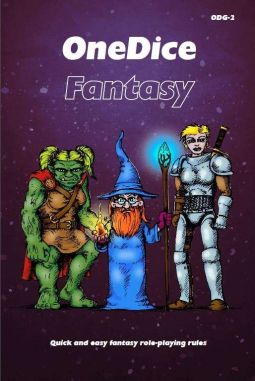
Isle of Harris, Scottish Hebrides.
Still bleeding from the last trap, the wounded warrior positions himself against the wall on the hinge side of the door, leans out and turns the handle.
SLAM!
The door swings open with surprising force and whacks him like a fly swat.
And outside the window, the dark clouds sweep in from the Atlantic. Rain rattles on the glass.
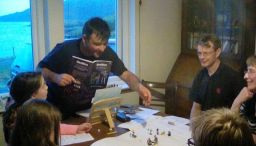
Yes, we’re playing OneDice Fantasy on the Isle of Harris, practically the edge of the world. Step out the door and swim the wrong direction and the next stop is the USA. (Go take a look at where we stayed.)
Around the table are my wife and both kids — 13 and 8 –, plus the drummer from my old rock and roll band, his wife — a novice player — and their two kids, 11 and 8. It’s their son’s Fighter who just took several points of damage from an old school dungeon. His little sister, meanwhile, is having fun being an elf.
It’s more adults than I’ve ever GM’d at one go, and actually more people. However, the rules are easy to run so I’m surviving.
Skeletal ferryman aside, it’s not quite Nerd Outreach Beyond the Styx. Our hosts were already keen players of co-op games like Forbidden Island and Warhammer figures have already invaded the table in the lounge. That’s why I brought a selection of OneDice books with me on holiday… that and the chance to actually read them in depth.
The OneDice engine is like Fate, but more simulationist and using only 1D6…
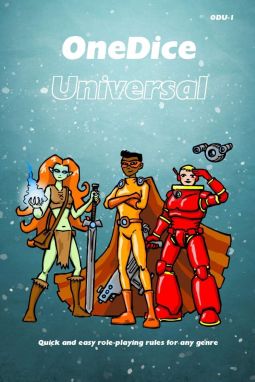
OneDice Character Generation is points-based, with only four attributes (number four, Magic, being optional), three derived attributes, and a few dozen generic skills. Improvement is through an Experience and Level system.
Most roles are 1D6 + Skill versus a target number or the opponent’s Defence. What’s left over is Damage, to which you add the weapon’s bonus and subtract any armour.
This is simple and quick, but does impose a hard upper limit. If your skill is 2 and the target number is 9, then you can’t succeed without spending one of your handful of Stunt Points.
Even inexperienced players quickly learn not to take stupid chances and to explore other roleplaying solutions… to lure the unkillable giant lizard away from the door, and to perhaps talk past the dragon. However, there will be opponents who simply can’t harm you! (The OneDice Pulp book rules cope with this by having rules for hordes of Mooks. I tend to house rule “exploding dice”, as in a natural 6 lets you add another dice.)
An obvious hazard is that Stunt Points can feel like a cheap workaround undercutting the feeling of simulation, and negating the payoffs in character design. An adept GM could handle this by varying the threat level in order to drain off the points, but there’s a risk of the game being about the points. However, you could just take them out or limit their use.
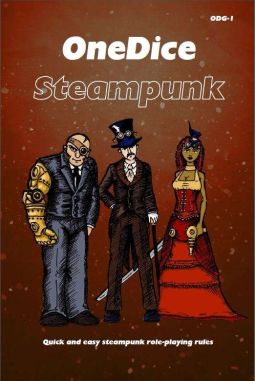
Overall, OneDice is childishly easy to play without actually feeling childish. Younger players quickly grasp the rules, and it would certainly be feasible for a 10 year old to contemplate GMing — though “lite” can be a mixed blessing, since it trades the authority of having detailed rules for ease of use.
Each book comes with the core rules, some genre specific additions, and then one or more optional “Skins”. I took four of these slim volumes on holiday:
OneDice Universal, basically the game engine plus comprehensive generic equipment lists — a downside being that younger players may be confused by seeing a laser-stick listed next to a spear. There are three skins, each with some additional skills plus new rules: generic “Fantasy”, including Wizard Spells; “Super Heroes” including super powers and weaknesses; and “Space”, with a handful of space ships and a guide to winging it. The skins are really, really thin. However, they’ll work fine if you want to do an old-school game on the fly or as a one shot. As with all these books, the advice and pointers are terse but incisive. The designers are veteran gamers in addition to being veteran designers. (NB You don’t need this book to use the other books.)
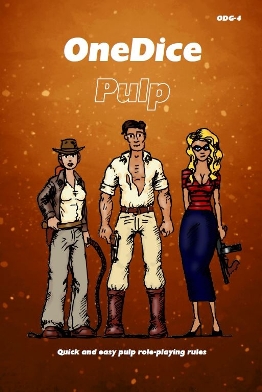
OneDice Fantasy gives you a vaguely renaissance setting that recalls Warhammer Fantasy RPG. There’s barbarians and swords, but also black powder weapons and clockwork tanks, if you want them. There are the usual character classes, with rules for generating them, plus different schools of magic and, of course, monsters. The one thing that seems to be missing is any sort of “detect magic” ability (I house-ruled that the Magic attribute could serve as a skill in its own right). There’s also twenty pages detailing an optional setting, basically our geography plus fantasy creatures, and an ongoing gnome versus troll feud. It looks like good stuff if you want an off-the-shelf campaign world.
OneDice Steampunk does what it says on the packet of rivets. I’ve GM’d this very successfully for my daughter and her friends (from about age 8+). Characters divide between being Haves and Have Nots, which has become our way of discussing actual social history… educational! My one niggle is the vast resources available to Haves. I tend to rule that 10% of starting money is available as passive income per year. Three skins cover “Machine Worlds”, “Lost Worlds” and “Gothic Horrors”, giving us a lovely range of monsters ranging from automatons, through ghosts, to dinosaurs. Again, there are pointers on how to make each of these work.
OneDice Pulp covers oldschool Pulp. It feels like the meatiest of the four, with extra rules for Talents, Magic — more Lovecraft/Howard than Vance –, and Mooks, and a lively listing of creatures that includes Nazi Officers, Alien Masterminds and Ancient Romans! A chapter lays out the main setting, “Pulp Earth”. It succinctly captures the flavour of the 1920s-30s world, then provides advice and stats for all the tropes, including (selecting at random): lairs, lost cities, lost worlds, hollow earth entrances, mysterious mountains, Nazi bases, flying saucers, stun cannon, pyramids, weather machines, weird science… Then we come to the “skins”, with short sections neatly capturing a sub genre plus adventure seeds. “Horror” includes sensible but detailed sanity rules, plus Lovecraftian creatures. “Science Fiction” gives us more or less Flash Gordon does Barsoom. “Fantasy” takes us to something not unlike Conan’s Hyborian age, complete with giant apes and lizard men. These sections are all short, but elegantly so.
Each of these slim volumes exquisitely embodies its genres, such that you can reasonably expect players to fall into emulating even unfamiliar types of story.
The “lite” ethos makes them easy to play and GM because there’s not much to remember. However, it also means that you would be unwise to try to run games in genres that you don’t already consume. It’s not enough, for example, to merely like the old Pulp aesthetic, you have to actually go and read the books! (Fortunately, the Megapack series makes these available as really cheap ebooks….) It follows that if buying for a young gamer to GM, you need to pay attention to what they’ve read, watched and played. This is most likely to be Steampunk or Fantasy.
If you are an adult gamer looking for generic rules to support a variety of oneshots, or to adapt to your own vision, then OneDice Pulp is possibly a better choice than Universal since the former has rules for mooks and for sanity, and the latter’s Science Fiction skin though useful is not very rich. Otherwise, buy the volume aimed at your genre, since, ultimately, genre emulation is what these books are good at. You can get them all and more at RPG Now.
M Harold Page is the Scottish author of The Wreck of the Marissa (Book 1 of the Eternal Dome of the Unknowable Series), an old-school space adventure yarn about a retired mercenary-turned-archaeologist dealing with “local difficulties” as he pursues his quest across the galaxy. His other titles include Swords vs Tanks (Charles Stross: “Holy ****!”) and Storyteller Tools: Outline from vision to finished novel without losing the magic. (Ken MacLeod: “…very useful in getting from ideas etc to plot and story.” Hannu Rajaniemi: “…find myself to coming back to [this] book in the early stages.”)
The place you guys stayed at looks like where An American Werewolf in London first started filming.
But I’m a dumb American so every Scottish country scene probably looks like that!